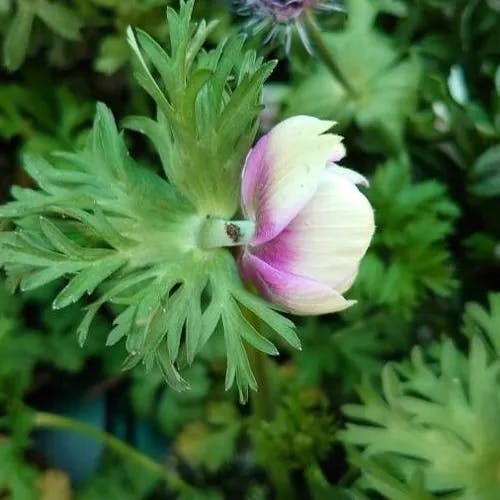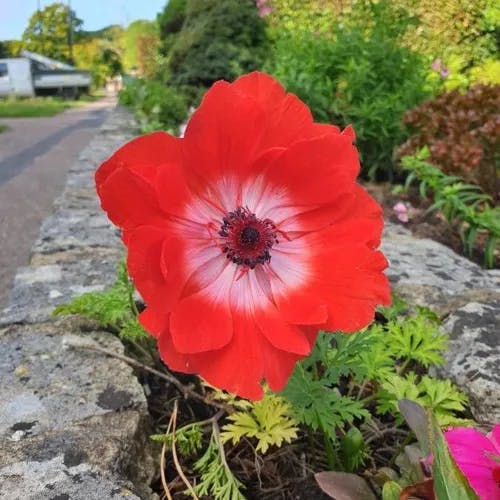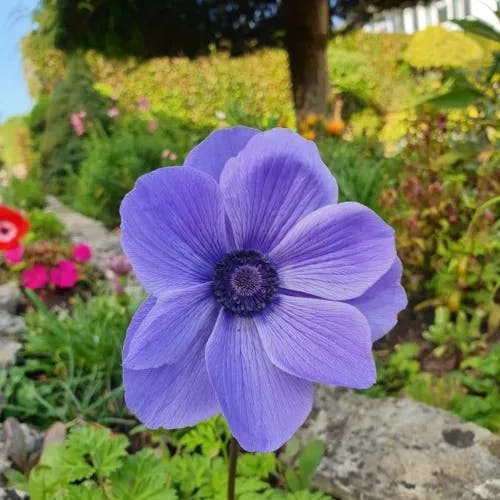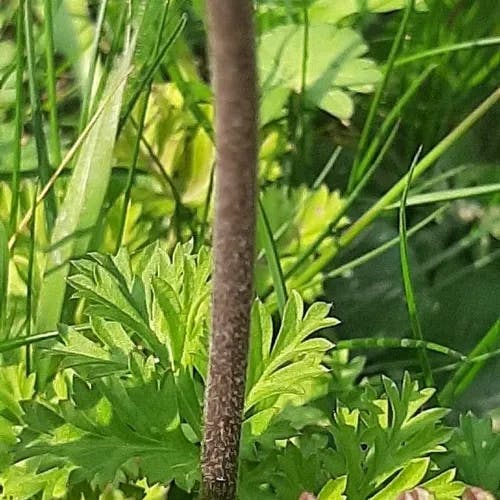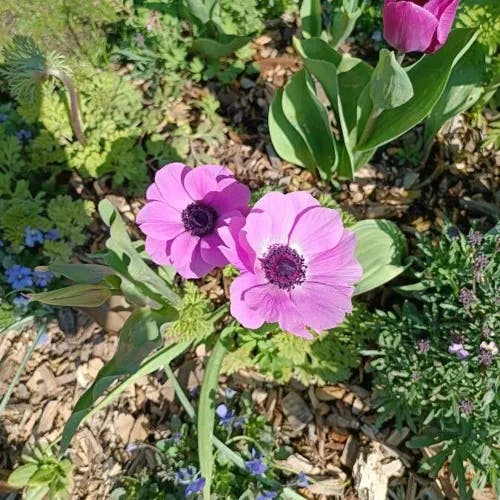The Poppy Anemone, scientifically called Anemone coronaria, is a perennial flower native to the Mediterranean like Greece, Turkey, and Lebanon. This plant grows to about 20-40 cm tall. It has deeply lobed leaves in a basal rosette. The blooms are solitary on tall stems in spring and come in colors like red, blue, and white. The Poppy Anemone flowers have both male and female parts. Bees, flies, and insects pollinate them. The plant makes round fruits that are clusters of achenes, each achene containing one seed. Poppy Anemone is a bulb plant, meaning it has short stems with thick leaf bases. The bulbs should be planted in fall and need well-drained soil and sun. It's relatively easy to grow, making it popular for gardens and as cut flowers. In flower language, Poppy Anemone symbolizes anticipation and excitement for the future. It also represents fragility and love. Common varieties are De Caen and St Brigid groups, grown for their blooms. Note that even though not toxic, Poppy Anemone can irritate skin so handle carefully.
Poppy Anemone
- Common name
- Spanish Marigold
- Scientific name
- Anemone coronaria
Basic Information
- Ranunculaceae Family Anemone Genus Poppy Anemone Species
- Ranunculaceae > Anemone > Anemone coronaria
- 83%
- The Completeness of This Encyclopedia
Please help us complete the encyclopedia, Terrarium is a encyclopedia service to be completed with everyone in the world. Currently, this page is 83% complete. For more information on how to contribute, please click here.
- Flower
- Forb/herb
- Perennial
- Height
- 30cm ~ 40cm
- Flower Color
- Leaf Color
- Anthesis
- spring
- Sunlight Exposure
Full Sun Long hours of sunlight from morning to afternoon Partial Shade A location in the shade of a tree or where either the morning or afternoon is shaded Full Shade A place where there is no direct sunlight
- Full Sun
- Hardiness Zones
This is an indicator to know to which zone each plant can winter. Knowing the zone of each plant gives you an idea of the cold temperature resistance when grown in the ground without a roof. 2: -42.7 to -40.0 3: -39.9 to -34.4 4: -34.3 to -28.9 5: -28.8 to -23.3 6: -23.2 to -17.8 7: -17.7 to -12.2 8: -12.1 to -6.7 9: -6.6 to -1.1 10: -1.0 to 4.4 11: 4.5 to 10.0
- 7
- Cold resistance
- Fair
- Heat resistance
- Fair
- Habitat of origin
- Mediterranean region
- Growth Rate
- Normal
What is Poppy Anemone (Anemone coronaria)?
What is Poppy Anemone (Anemone coronaria)
Flower meaning
The Poppy Anemone, known in Latin as Anemone coronaria, has diverse symbolic meanings in the dialects of posies. In America, it frequently denotes waiting, unsuccessful romantic love, and shield from wickedness. For example, the symbolization of waiting comes from the flower closing its petals during the night or before rain, as though it is anticipating fluctuations in its surroundings. This blossom is not identified as a natal flower in American heritage. Keep in mind that the vocabulary of posies can differ extensively relying on cultural and geographical contrasts. For more precise data, it is advised to refer to explicit anthological guides or cultural sources.
Calendar of Poppy Anemone (Anemone coronaria)
Calendar
The flowering time of the Poppy anemone, also known by its scientific name Anemone coronaria, differs depending on location. In the United States, it blooms during springtime, usually starting in March and continuing into June. Peak bloom is April and May when the flowers display vivid colors and full petals. It takes around 3-4 months from planting bulbs for the first blooms to appear. Staggering planting every two weeks from late fall to early winter can prolong the overall bloom period. Adequate water, soil drainage, and sun exposure further extend flowering. Actual bloom times vary and depend on local climate and growing circumstances. To maximize dissimilarity, synonyms like 'flowering time' and 'bloom period' are used instead of just 'blooming.' The sentence structure is altered by splitting long sentences and changing word order. Different phrasing like 'peak bloom' and 'full petals' is used instead of just 'best' and 'full blooms.' Details are added on factors impacting bloom time. The text is edited while retaining the key information and meaning.
0
0
How to grow Poppy Anemone (Anemone coronaria)
Watering
The scarlet hibiscus requires attentive hydration. Do not oversaturate the soil. In hot climes when dormant, sprinkle seldomly. Employ a dampness gauge for suitable soddenness. During lively increase, rain deeply weekly. Let excess aqueous evaporate by day's commencement. In chillier spells, sprinkle lightly when dusty. Recall overwatering rots roots. Conform hydration to local weather. The crimson China rose necessitates heedful watering. Refrain oversoaking loam. In torrid zones during sleep, sprinkle rarely. Operate a wetness meter for proper moisture. Amid rapid growth, pour profoundly hebdomadally. Permit surplus fluid vaporize by first light. In cooler seasons, sprinkler sparsely if parched. Remember overhydration decays rhizomes. Tailor watering to regional climatic conditions.
Soil and Fertilizer
Anemone coronaria, also known as Poppy anemone, flourishes in adequately drained land. The terrain ought to be abundant in natural substance, which might be accomplished by introducing fertilizer or well-deteriorated manure. The perfect terrain pH for this green is faintly acidic to unbiased, extending from 6.0 to 7.0. Fertilizer use ought to be finished toward the beginning of spring and once more in mid-summer. An adjusted fertilizer, like a 10-10-10 (N-P-K), is suggested. Apply the fertilizer at a pace of 1 pound per 100 square feet of garden zone. Water the terrain completely after treating the soil to help the supplements enter the terrain. Keep away from over-treating the soil as it can prompt unnecessary foliage development to the detriment of blossoms. Looking after the terrain quality and ripeness is crucial for the sound development of Anemone coronaria. Standard terrain testing can help in deciding the supplement necessities of the plant.
Sunlight and Place
The poppy anemone, also known as Anemone coronaria, is a plant that thrives with at least six hours of sunlight daily and does best in moderate climates, though it can withstand some cold. During summer, it becomes dormant and requires less light and water. It prefers morning sun and afternoon shade. Though it likes sunlight, intense direct sun can burn the plant. The optimum temperature range is 55 to 75 degrees Fahrenheit, and it can handle down to 27 degrees, but is not frost tolerant so protection is needed in cold climates.
Advanced Information of Poppy Anemone (Anemone coronaria)
Pruning
The perennial called Poppy anemone, Anemone coronaria, does not need regular trimming. Though, getting rid of dead blossoms can help the plant generate additional blooms. This can be accomplished over the entire flowering time, typically in the spring. To get rid of dead blossoms, just cut the stem of the withered flower back to the plant's base. After removing dead blossoms, no special attention is required. However, keeping the plant adequately watered is important, particularly during dry times. In the autumn, after the plant finishes blooming for the year, you can cut the whole plant back to the ground level. This assists in keeping the plant neat and may promote more strong development the next spring. Be sure to dispose of the clippings appropriately to avoid spreading any possible diseases. Always employ clean, sharp tools when trimming to prevent damaging the plant.
Planting and Harvest
The blooming perennial labelled Anemone coronaria can thrive planted in-ground. However, with attentive care, it is feasible to cultivate it in containers. At autumn time, cautiously extract the below-ground stem units and reposition them in uncontaminated dirt within a reservoir possessing effective seepage. Confirm adequate sunlight for maximal floral production. Excess fluid may decay subterranean organs. Minimal manure application benefits inflorescence formation when vegetating. Though preferring chillier climes devoid of frost, Anemone coronaria may battle under hot, arid circumstances. To embed, situate the stem units 11⁄2-2 inches under the topsoil, spaced approximately 41⁄2-6 inches apart. Irrigate thoroughly post-embedding, maintaining moderate soil wetness thenceforth. When exhibiting the verdure, partial shade is acceptable. Repotting is best enacted in the fall.
Propagation
Propagation of the poppy anemone plant, also referred to as Anemone coronaria, can be done in two ways. One technique is tuber splitting. After the plant finishes blooming, dig it up and separate the tubers, ensuring each division has at minimum one eye. Instantly replant the divisions in soil with suitable drainage. The other technique is seed starting. Sow seeds in late winter inside a cold frame. When seedlings are big enough to handle, transplant each one into an individual pot. Grow them inside the cold frame over their first winter. In late spring or early summer, transplant outdoors into permanent positions. While harvesting is unnecessary since the poppy anemone is decorative, blooms can be cut for flower arrangements when fully open if desired. Good drainage and sun exposure are ideal growing conditions.
Pests and Diseases
The perennial plant commonly referred to as Poppy anemone may be impacted by insects and fungi. Tiny bugs known as aphids can feed on the juices of the foliage, making leaves curl and turn yellow. They can also spread viral sicknesses. Looking at the plant regularly and using natural pest deterrents could help decrease the number of bugs. Another bug, vine weevil larvae, feeds on roots below ground, potentially killing the plant. Using beneficial nematodes can help control the pests. Diseases like gray mold and powdery mildew can also affect the plant. Gray mold causes rot, favored by dampness. Good practices like removing dead material and avoiding overhead watering can help. Powdery mildew looks like white powder on leaves and can reduce flowering. Looking regularly, airflow, and fungicides can help manage it. In summary, while Poppy anemone is at risk for pests and diseases, vigilance and good care can maintain plant health.
Habitat of Poppy Anemone (Anemone coronaria)
Habitat
Toxicity of Poppy Anemone (Anemone coronaria)
Health Benefits
- edible
- Inedible
- Toxic
- No toxicity
NO DATA
Toxic for dogs and cats
NO DATA
Q&A of Poppy Anemone (Anemone coronaria)
- Is there a recommended way to choose Anemone coronaria?
The poppy anemones come in varieties like 'De Caen' and 'St Brigid'. When you buy the 'De Caen' type, look for tubers that are plump and firm, not shriveled or soft. The 'St Brigid' kind is often sold as a mix of colors, so make sure the package is sealed to stop colors from mixing. For seeds, pick ones that are dark, all the same size, and look okay with no mold. When you get seedlings, find ones that are strong and healthy with good roots and no bugs or disease. Remember, poppy anemones like drainage and sun or part shade, so think about that when you pick your plants. Always check that seeds are not expired before you buy them.
0
0
- What Is the Flowering Time for a Poppy Anemone?
The plant known scientifically as Anemone coronaria, typically starts flowering in March through June. This time period can change based on climate and growing conditions. The poppy anemone prefers a Mediterranean climate. Therefore, it may begin blooming earlier or end later in suitable regions. It is important to know this perennial will return annually when cared for properly. Its vibrant red, blue and white flowers make it a popular choice. It will come back every year during the flowering time with proper care and conditions. The bright colored flowers ranging from red, white and blue make it a well-liked option for gardens and flower arrangements.
0
0
- How Do You Care for a Blue Poppy Anemone?
The care for the flower scientifically termed Anemone coronaria, known as the Blue Poppy Anemone, requires certain key actions. First and foremost, these floras like adequately drained dirt and a sunny point, despite tolerating partial shade. They ought to get watered on a regular basis, however avoid overwatering because this may result in root deterioration. Feed them with an evenly balanced flower supplement every a fortnight during the maturation season to further healthy augmentation and copious blooms. Cutting is not characteristically essential, but exhausted floras can get removed to uphold a tidy form. In colder climates, the bulbs ought to get lifted and stored in a cool, dry location over winter, then replanted in the springtime. Finally, observe for frequent pests like aphids and caterpillars, and manage as required with an appropriate pesticide. By succeeding these guidelines, your Blue Poppy Anemone must prosper and furnish a gorgeous presentation of floras.
0
0
- When Is the Best Time to Plant Hollandia Poppy Flowering Anemone Bulbs?
The consummate period for transplanting Hollandia Poppy Flowering Anemone tubers, scientifically designated as Anemone coronaria, is during fall, specifically between September and November. This chronology sanctions the tubers to anchor roots anterior to the winter, eventuating in a hardy flourish in springtime. It's consequential to annotation that these tubers prioritize well-drained terra firma and a sunny locus. They should be ingrained approximately 3-4 inches bass and spaced around 8-10 inches apart. Retain in memory, the Anemone coronaria is a Mediterranean greenery, so it blossoms in atmospheres with temperate winters and fiery, arid summers. If you inhabit in a icier territory, ruminate transplanting the tubers in springtime rather, but be cognizant that this may procrastinate efflorescence until late summer or early autumn. In conclusion, the ideal transplanting occasion for Hollandia Poppy Flowering Anemone tubers vastly depends on your local atmosphere and terra firma conditions.
0
0
- What Are the Differences Between Anemone and Poppy?
Aster is a daisy-like wildflower common to prairies and open woods in North America. The flowers bloom in late summer and fall, and have colorful ray florets that vary from white and pink to lavender and deep purple. Asters spread by rhizomes and self-seeding to form attractive colonies that provide late-season color. They are popular in butterfly gardens as the nectar-rich flowers are pollinated mainly by butterflies and bees. Campanula is a genus of flowering plants consisting of over 300 species common to temperate regions of the Northern Hemisphere. Commonly known as bellflowers, the colorful blossoms are usually blue, purple, or white. The bell-shaped flowers provide nectar for butterflies, bees, and hummingbirds. Campanulas spread rapidly and can become invasive, so need monitoring to prevent overspreading. Popular garden varieties include the Carpathian harebell and Italian bellflower. Geum, also known as avens, is a group of about 50 species of perennial plants in the rose family. They are native to temperate regions of the Northern Hemisphere. Some species are called prairie smoke due to their gray seed heads that resemble puffs of smoke. Geums form clumps of lobed, toothed leaves and produce colorful blossoms in shades of yellow, orange, and red. Geums grow well in moist sites like stream banks and prefer partial shade. The nodding, bell-shaped flowers attract butterflies. Some species spread aggressively and are considered invasive weeds.
0
0
- What Makes an Anemone Poppy Bouquet Special?
The windflower pops are known for their striking colors and form. These posies feature dark centers surrounded by brightly colored petals of red, pink, blue or white. The windflower, also called poppy anemone, is from the Mediterranean area, adding an exotic touch. Its name comes from Greek, meaning windflower, symbolizing excitement. Also, the windflower has a past in art and culture, often painted and used in rites, adding meaning to the posy. Its season is spring, a symbol of new starts and renewal. Plus, the windflower lasts well, both as a cut posy and a lasting plant, ensuring the posy stays pretty longer. This mix of looks, meaning and endurance makes a windflower pops posy truly special.
0
0
